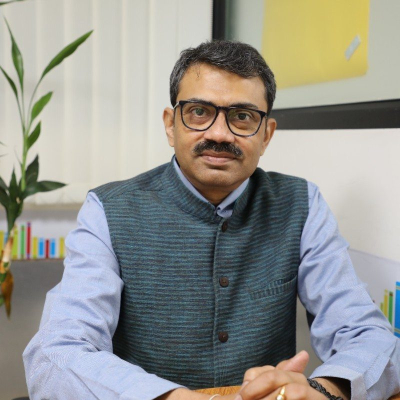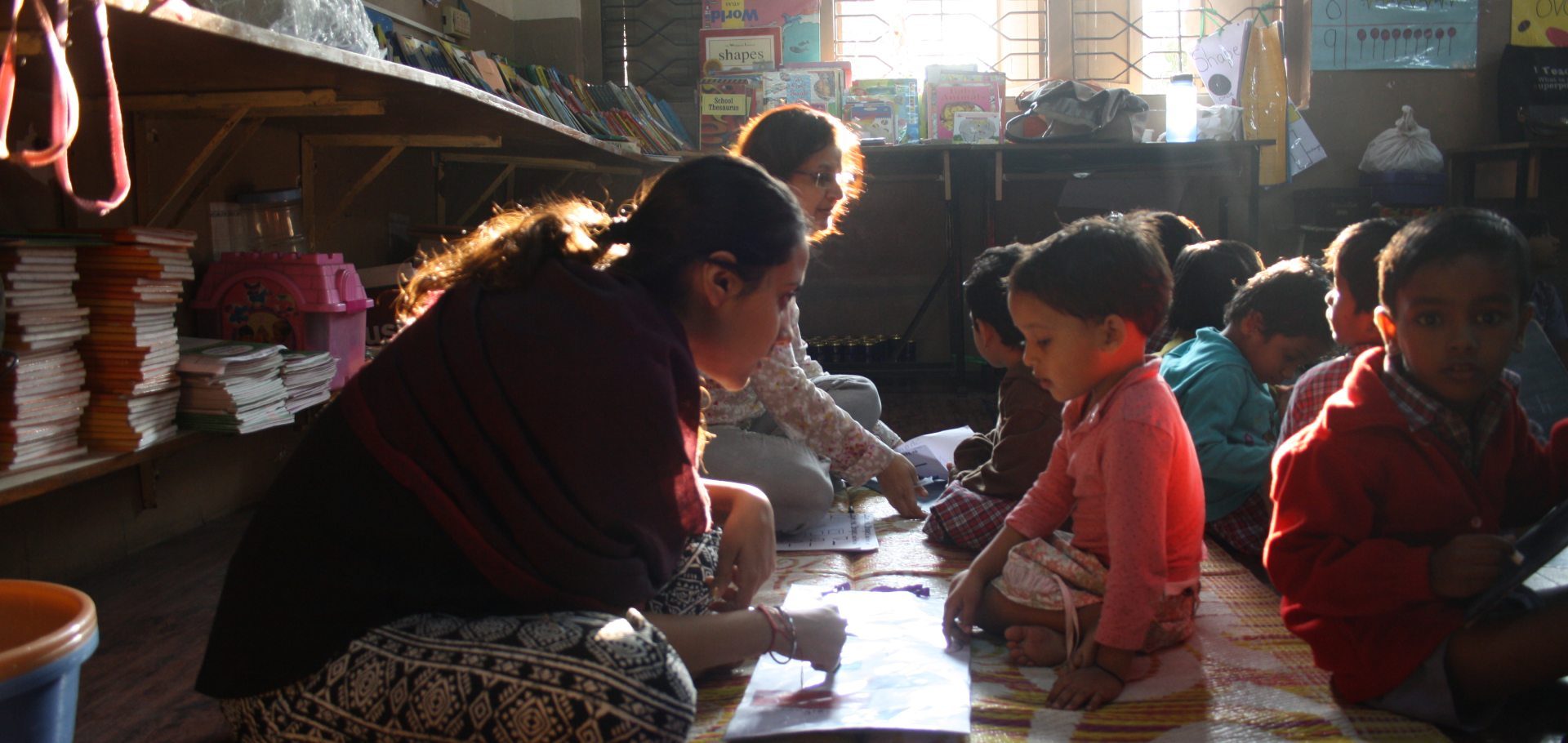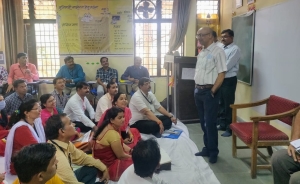Many states recently conducted or are planning teacher trainings on Foundational Literacy and Numeracy (FLN) for primary grade teachers to build capacities and understanding on concepts, pedagogy and materials under the NIPUN Bharat Mission. We spoke with Sourav Banerjee, Country Director, Room to Read, on the importance of teacher training, elements of a successful training program, and his learnings from the recent training in Madhya Pradesh.

CSF: Face-to-face training has been the main mode of teacher training for many years. During pandemic-induced school closures, new digital, blended and decentralized models of training emerged. How do you see teacher training shaping in India?
Sourav: Teacher training has largely been done face to face over the years. However, face-to-face training has certain challenges :
- The lack of availability of teachers and training days which leads to situations where some teachers are not able to attend the training or attend it partially;
- Arranging for logistics which consumes teachers’ time and is costly;
- Dilution of cascade as most training, when done in a government set-up and at a large scale, need multiple layers;
- Many times, training in remote areas means no access to projectors or screens to conduct presentations.
Lately, attempts have been made to look at various digital and blended modes of training. These have a set of advantages such as lower cost, fewer logistics, learning at one’s own pace, and flexible number of days for each training program. This form of training is multimodal and you can make it interesting with the use of visuals. It is also much easier to deliver.
Since digital training is an easier and more convenient way to reach out to teachers, it is going to continue to be used in future. However, it does come with challenges, the main one being lack of facetime between the trainer and the teachers.
At the end of the day, each training program is not only about delivering concepts, but also about the human connection between the trainer and trainee. When you are delivering a piece of content, there are bound to be discussions around it, where people will share different views. This becomes restricted in a digital mode. Human connection does have an impact on the quality of training and a lack of it is a major disadvantage digital training.
The other scenario where digital training is inefficient is in programs, where demonstration is important.
Training can be of two kinds:
- Concept building training, where you are training on a topic to build knowledge;
- Demonstrative training, where we try to demonstrate different ways of delivering instruction. This is more targeted towards classroom delivery.
Therefore, whenever there is a training that focuses on classroom instruction, where you want to show the teacher how certain things can be done, digital becomes relatively restricted. Face-to-face training allows for demonstrations and feedback.
It is too early to have longitudinal assessments that can prove the effectiveness of digital modes of training. There are problems with both of these models and going forward, it would be ideal to have a mix of both, where you have face-to-face training, but you supplement it with digital content wherever and however possible. We are looking forward to a blended form of training. Governments should look at planning for this.
CSF: What are some of the key elements for a successful teacher training program? How should a state design and plan a multi-year Teacher Professional Development program?
Sourav: Some key elements for a successful training program are:
- A clear intent by the state to look at teacher training as a capacity building exercise, and not just a task to finish in order to utilize allocated funds;
- Conducting a teacher needs assessment to map their competencies as opposed to competencies you want teachers to have;
- Conducting a diagnostic assessment of classroom practices as a precursor to the teacher needs assessment. This is to find out what is currently happening in the classrooms, what the teacher needs to do to improve teaching, etc;
- Tailoring the mode of training as per the type of training. For example, a training on classroom management or general pedagogy needs to be more experiential, hence, a face-to-face mode works better. Concept building training can be different. Training that involves building teachers’ capacity on any subject has to be delivered a bit more differently; it can use digital material to build prerequisite knowledge. However, beyond the training, it is also important to continuously support teachers with reading materials and assignments to ensure a continuous dialogue and build further capacities;
- Determining the right cascade in a large-scale government training program and ensuring the learning loss in each level of cascade is minimal;
- Selecting the set of master trainers well. It is important to invest more in the training of master trainers than the number of days they would go on to train.
- Ensuring availability of well-designed materials that support the training such as trainer guides, manual, modules etc; supplemented by videos, audios, infographics etc.
- Supporting the teacher onsite in the classroom through BRPs/CRPs (Block Resource People and Cluster Resource People) or other resources;
- Continually assessing what the program is achieving against what was envisioned. Some questions to consider are whether your program inputs are leading to the right kind of classroom practices and the right kind of mindset changes.
CSF: How does one track the impact of the training or the overall professional development program so as to know whether it is leading to the intended results?
Sourav: The assessment of a teacher training program or a teacher capacity building initiative is actually very nuanced. It is important to first determine the objectives of the program – is it to change teacher mindsets, teacher practices in the classroom or to increase teachers’ knowledge? Each of these will have a different matrix.
Assessments on topics can partly be achieved through a pre and post test, but they have to be followed through to see what are the practices that are changing in the class. Few factors to bear in mind are: Is the teacher interacting more with the child? Are read alouds happening in class?
CSF: Most of these trainings happen at the block and district level. How do you align on the goals of the program with other stakeholders in this system?
Sourav: It starts with the intent and messaging. If we focus on building long-term teacher capacity instead of seeing it as only completing a few teacher training sessions, the same message will go to institutes like District Institute for Education and Training (DIETs), since they are the ones who support teacher capacity in districts. Involving DIETs is intrinsic to the development and execution of the training program. Often, they are almost kept aside from the program. As a result, the system somewhere gets a message that what is important is to just get the training completed.
Identifying champions at the highest level who understand the importance of teacher training is also important for building intent in the system. We also need to build incentive structures for teachers within the system. It also worked in many countries. Efforts have been made in India but didn’t succeed. If teachers have a career path, they will be more interested in building their capacities.
CSF: Recently, Room to Read was instrumental in designing and supporting a face-to-face training of 90,000 teachers in Madhya Pradesh. How was your experience? What went well and what do you think was something that could be improved?
Sourav: It was a great learning experience for us. We have been conducting teacher training at a large scale for the last ten years. However, this was the first time where we were involved from the beginning till the end of the program- from designing the training to rolling it out as well as conducting follow-ups.
What went well:
The way in which the master trainers were selected, cascades were chosen (how many people at what level would get trained), and selection of the number of days was meticulous. State-level trainers were involved early on in the program which worked well.
The training was also very well managed; all logistics were taken care of on time which significantly impacted the training. The multiple rounds of reviews that the training content went through helped refine content and build ownership within the government. Government leaders visited the training almost every day and gathered feedback from the participants. This helped communicate the importance of training.
What could have been done better:
What definitely needs a relook is the engagement with the master trainers. A much deeper engagement needs to happen with them, given how many master trainers were unable to understand the essence of what was meant to be delivered. The engagement with them should not just be limited to a five-day training program and has to be more continuous and for more days to build greater capacity.
We also should have given more time for demonstrations. Since the training duration was short, we had to pack a lot of things in the plan such as building a conceptual understanding and, at the same time, building on how teachers are going to translate it in the classroom. Ideally, we should have had an exhaustive demonstration session where master trainers would come to the board and demonstrate practices.
Another issue that can be resolved in the next few training cycles is the lack of availability of academic materials such as teacher guides, textbooks, workbooks at the time of training. We ended up using stock copies and digital versions, which were relatively less effective.
It is important to note that for practices to change, exhaustive training programs for the next three years are needed. A five-day training might not help with long term change. We have been able to make a good beginning in Madhya Pradesh. If we can follow it up with regular training, additional inputs with videos, audio, classroom support, reading materials and on-site regular engagement, the impact would be sustained.


